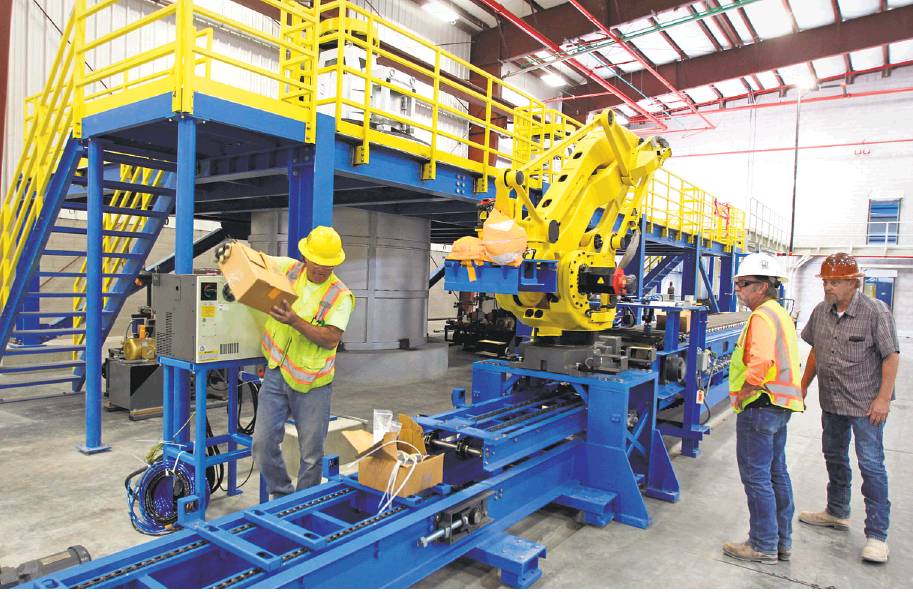By David R. Baker
SPARKS, Nev. — Tesla Motors’ massive Gigafactory in the Nevada desert wants to show the world a better way to make batteries.
And just 3 miles away, a plant built by a Bay Area startup will pioneer a cleaner, cheaper way to recycle them.
Aqua Metals, based in Alameda, threw an opening party Thursday for its first battery recycling center, separated from the Gigafactory by a few dusty hills.
The $30 million AquaRefinery will use a new electrochemical process to recycle the lead from lead-acid batteries, which supply electricity to the vast majority of the world’s cars. The Gigafactory, in contrast, will build lithium-ion batteries — the type favored in electric vehicles — for Tesla’s cars.
Aqua claims that its process will release far less pollution, and leave far less waste, than the traditional way of recycling lead batteries — melting them in a high-temperature smelter. It will cost less, too, said Chief Commercial Officer Steve Cotton.
“Nobody does something green unless there’s a greenback associated with it,” Cotton said. “The world is coin-operated.”
There’s certainly a need.
Only one smelter still exists on the West Coast, after the closure of an Exide Technologies plant in Los Angeles County that for decades released dangerous levels of lead and arsenic into the air. Exide agreed last year to permanently close the facility and clean up the surrounding area to avoid criminal prosecution.
Aqua’s process releases no arsenic, almost no measurable lead, and less than 1 percent of the sulfur dioxide produced by smelting, according to the company. Unlike smelting, it sends no lead slag to landfills. And since most of the process occurs at room temperature, it produces about one-fifth of the greenhouse gases spewed by a smelter.
“There’s a real way to make this almost waste-free,” said Selwyn Mould, Aqua’s chief operating officer.
The process won Aqua a Rising Star award this year from Platts, a global energy and commodities information company. More importantly, it landed Aqua a $10 million investment in May from Interstate Batteries, a major battery retailer and recycler with operations throughout the Western Hemisphere and China. Interstate also agreed to supply Aqua’s Nevada facility with 1 million used batteries.
“Interstate Batteries seeks out innovation, pursues opportunities and invests in the technology we need to succeed not just today, but also tomorrow,” said Interstate CEO Scott Miller in a press release announcing the deal.
Founded in 2013, Aqua had a $36 million initial public offering last year. It received a $6 million private investment in 2014.
For its first AquaRefinery, the company chose the Tahoe-Reno Industrial Center east of Sparks, a vast stretch of hilly, barren land where wild horses roam. While it may seem remote, the site is linked to the Bay Area by Interstate 80, and by a railroad that crosses the Sierra at Donner Pass. Nevada officials made clear to Aqua that they wanted the facility.
“When we came up to Nevada, they said, ‘How can we help?’ ” Mould said. “In California, you put in your permit application, and six months later, someone tells you you filled out line 26 wrong.”
Despite Thursday’s opening party, the facility isn’t quite finished. But Cotton expects it to hit full production by the end of the year.
The AquaRefinery will take in used batteries by truck, drain and collect the acid, then place the batteries on a convey-er belt that climbs two stories. At the top of the belt, a hammer mill will smash them to bits, sending the pieces through a series of machines that separate the lead from the batteries’ plastic components. The plastic will be gathered and recycled.
The facility’s heart is a collection of enclosed plastic bins, each shaped like a small house with a peaked roof. A liquid solution containing lead from the batteries will be pumped into the bins, which use a current of electricity and slowly spinning blades to precipitate the lead from the liquid, separating the lead from impurities.
The separated lead, which looks a bit like metallic brownie batter, will slide down a chute from each bin and travel down a conveyor belt to a hydraulic press, which will stamp the lead into discs. The discs will then be melted in large kettles and poured into molds to create 22 inch-long lead ingots, also known as pigs. Those ingots, Mould said, will be nearly pure lead and will be sold.
While the process relies heavily on water, the AquaRefinery is designed to recapture and reuse as much as possible. Sulfuric acid from the batteries, for example, is separated into water and sulfate, with the latter converted into sodium sulfate crystals that can be sold for use in detergents. Depending on the composition of the batteries processed on any given day, the facility may even end up with excess water, Mould said.
“We expect to be water-neutral,” he said. “That’s a big deal around here.”
Aqua Metals has designed its technology to be modular and envisions a future in which battery manufacturers or distributors will install it at their own facilities. It could one day eliminate the need for smelters, Cotton said.
“I think once AquaRefining is running, you’ll see a new nuclear plant in the U.S. before you see another smelter,” he said.
David R. Baker is a San Francisco Chronicle staff writer. Email: dbaker@sfchronicle.com Twitter: @DavidBakerSF
See this article in the e-Edition Here »


